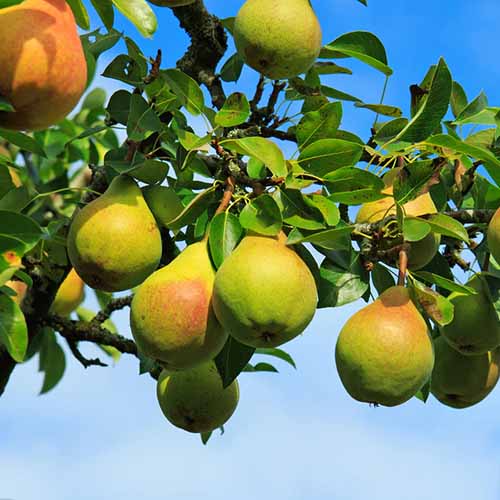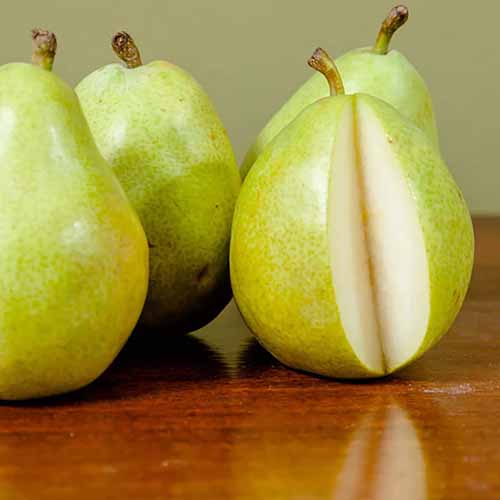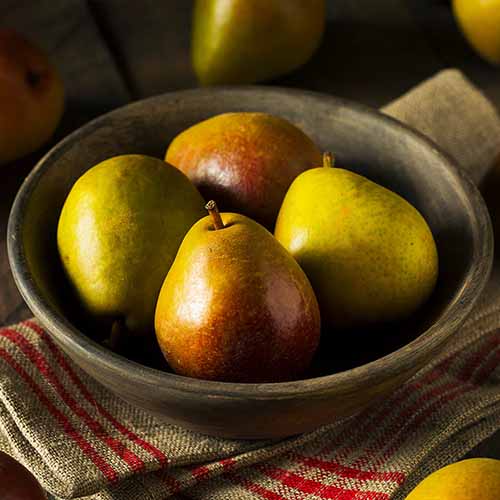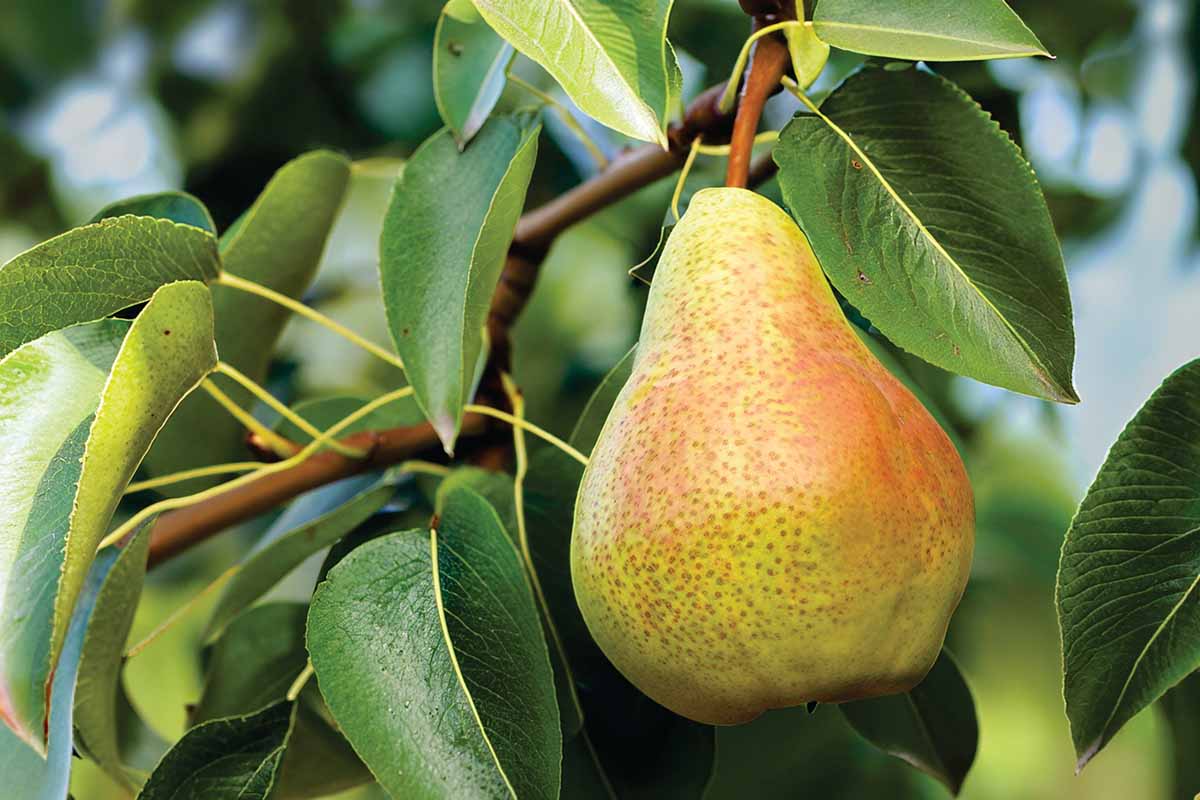Fireblight is a terror. It’s a bacterial disease that infects pears, plums, apples, and other fruit trees, transforming your plant from a luscious, productive specimen to an oozing, shriveled, blackened mess. And forget about enjoying any of the fruits.
Fireblight is caused by the bacteria Erwinia amylovora and is one of the most devastating diseases of pears.
When conditions are right for the bacteria, this disease can completely decimate an entire orchard in a single season.

We link to vendors to help you find relevant products. If you buy from one of our links, we may earn a commission.
It originated in North America and has spread to the rest of the globe, leaving experts scrambling to find and breed trees that can withstand the effects of infection.
Plant breeders have been successful and we have quite a few options now that are able to resist infection. This doesn’t mean the tree is completely immune to the bacteria, it can still become infected, but symptoms are significantly reduced.
Here are the pear varieties worth looking at if you want to avoid fireblight:
17 Fireblight-Resistant Pear Varieties
Asian pears are more susceptible to the disease than European cultivars, so you’ll mostly see the latter on this list.
Keep an eye on the Ontario pear breeding program under Frank Kappel, Richard Layne, Harvey Quamme, and David Hunter.
They released the Harrow series, which includes ‘Harrow Delight,’ ‘Harrow Gold,’ ‘Harrow Crisp,’ and ‘Harrow Sweet,’ among others. All of these are at least moderately resistant to fireblight and there are more to come.
The West Virginia USDA breeding program under Richard Bell is also working on some options with excellent potential that should hit the market soon.
Some pears require a pollinator to produce fruits. Unless we call out otherwise, ‘Bartlett’ is always a good pollinator for all the entries in this list.
It’s also the pear variety that growers compare others to in terms of when the fruit ripens.

‘Bartlett’
If you want to grab a ‘Bartlett,’ you can find trees available at Fast Growing Trees.
Many fruit trees also require what is known as chill hours. This refers to a certain number of hours during the winter where the temperature remains below 45°F.
Some states, like Florida, will experience fewer than 200 hours, severely limiting which pears can grow there.
New England is safely in the 1,600+ hour category, and the Pacific Northwest has the most in the contiguous states at over 2,000 in most areas.
Your local extension office should have a page dedicated to the chill hours in your particular area.
Finally, remember that resistant doesn’t mean immune. There are no trees that are immune to the ravages of E. amylovora.
Some will show few symptoms, others will rarely have any, and some of these options will have moderate symptoms but should still provide fruit. Learn more about dealing with fireblight in pears in our guide.
1. Ayers
‘Ayers’ is an extremely fireblight-resistant pear that provides an abundant harvest of large yellow and blush red fruits in Zones 4 to 9.
The flesh of the medium-sized, midseason fruit is sweet, smooth, and buttery.
This USDA Agricultural Research Service-bred tree is self-fruitful but growing a pollinator friend will increase yields. Released in Georgia in 1976, it quickly became a favorite for growing in the south and goes by the nickname “sugar pear” for its sweet flavor.

‘Ayers’
It only needs about 300 chill hours, making it a good choice for areas with warmer winters in USDA Growing Zones 5 to 9.
You can find ‘Ayers’ in five-gallon containers available at Perfect Plants Nursery.
2. Blake’s Pride
‘Blake’s Pride’ was bred by the USDA and Ohio State University and released in 1998 for Zones 5 to 9.
It’s highly resistant to fireblight and is often the one growers recommend for gardeners who have battled fireblight in the past.
If you’ve ever tasted a ‘Comice’ pear, the flavor is similar. The large, yellow-skinned fruit is sweet and juicy with a buttery texture.
The fruit stores for months and ripens two weeks after ‘Bartlett,’ making it a mid-late type. It needs about 750 chill hours and is not self-fertile, so it will require a pollinator.

‘Blake’s Pride’
It’s also tolerant of heat, which makes it perfect for areas with sweltering summers that cause many pears to falter.
You can find ‘Blake’s Pride’ available from Nature Hills Nursery in #3 containers.
3. Elliot
We have experts from the University of California in Davis, led by Dr. Kay Ryugo to thank for ‘Elliott,’ which they released in 1987 after hybridizing ‘Elliot No. 4’ and ‘Vermont Beauty.’ It was bred primarily for its resistance to fireblight.
The flowers might turn black but the infection typically doesn’t continue beyond that and the fruit develops normally.
This cultivar starts fruiting as young as three years old, at which point you can enjoy the yellow fruits with light russeting that have an excellent balance of sugar and acidity. It’s comparable to the beloved ‘Bosc’ in flavor.
‘Elliot’ stores well and can last up to four months in storage. It’s a midseason type and needs a pollinator partner. Grow it in Zones 5 to 9 where the tree will receive about 600 chill hours.
4. Farmingdale
‘Farmingdale’ is one of those rare cultivars that isn’t the result of intentional hybridizing, but a chance seedling with ‘Benjamin Buckman’ parentage at the Oregon State University Agricultural Experiment Station.
In addition to proving to be extremely resistant to fireblight, it’s also tough enough not to succumb to collar rot.
The midseason fruits have yellow-green skin with light russeting wrapped around white, juicy, buttery flesh.
It isn’t considered one of the most flavorful pears, but the tree’s vigor, uniform growth, and disease tolerance makes it an appealing option.
‘Farmingdale’ is also cold hardy, growing in Zones 4 to 8. It has been used regularly as a parent to breed new blight-resistant cultivars and as rootstock for hybrids.
5. Harrow Delight
‘Harrow Delight’ lives up to its name. The massive harvest is delightful, as is this plant’s resistance to fireblight and scab. Not to mention the sweet, juicy fruits.
This cultivar needs about 800 chill hours and don’t be surprised if it blooms prolifically one year and less so the next year. It’s hardy in Zones 5 to 8.
It’s not self-fruitful, so you’ll need to plant a friend. ‘Harrow Delight’ is in the late blooming group, but the fruits ripen early – ready two weeks before those of ‘Bartlett.’
Eat the fruits fresh or process them right away as they don’t store well.
6. Hood
Fear not, fair weather readers. ‘Hood’ is happy in warm climates, including Zones 7 to 10, and only needs 100 or so chill hours.
Although it’s partially self-fertile, find it a friend and you’ll have an even more abundant harvest.
Speaking of, the fruits are sweet, buttery, and fragrant with a greenish-white skin and white flesh.

‘Hood’
This is an Asian pear cultivar and requires a fellow midseason pollinator. While the trees can be subject to leaf spot, fireblight is a rare issue.
You can find five- to six-feet-tall trees available at Perfect Plants Nursery.
7. Kieffer
Experts aren’t 100 percent sure where ‘Kieffer’ originated, but it’s likely a natural hybrid cross between a Chinese and a European pear.

It was introduced by breeder Peter Kieffer in Philadelphia sometime in the late 1800s. The huge, juicy, rich, and sweet fruits are a manna from heaven and a favorite of commercial growers for canning.
‘Kieffer’ is ready to harvest a full month after ‘Bartlett,’ but it’s an early-midseason bloomer, perfect for Zones 5 to 9. Not only is it adaptable to many different climates, but it also has a low chill requirement of just 350 hours.
The fruits are medium-sized and somewhat tart with a crispness that hints to its P. prunifolia ancestry.

‘Kieffer’
The skin is golden with blush red around white flesh. It has an excellent shelf life and high yields even without a pollinator.
As far as fireblight-resistant options go, this one ticks all the boxes. It’s available from Fast Growing Trees in a variety of sizes.
8. Magness
When you ask pear experts about fireblight resistant cultivars, ‘Magness’ will undoubtedly top the list. This tree was bred by the USDA’s Maryland Agricultural Research Center in 1960 with ‘Seckel’ and ‘Comice’ parentage.
It has proven over the decades to be pretty much immune to the disease when the bacteria enters the shoots and flowers.
The disease can still enter through wounds, so take care when pruning or working around it (and all fruit trees). It’s also resistant to scab and mildew.
‘Magness’ can’t be used as a pollinator because its pollen is sterile.
If you choose this one, you’ll definitely need to plant a pollinator that can grow along with it in Zones 5 to 10 and that blooms in midseason.

‘Magness’
Be sure your region has at least 400 chill hours so the tree can produce fruit.
Once they mature, the fruits can store for months and are extremely flavorful and sweet, with a honeyed, buttery, sweet flesh with absolutely no grit.
The skin is a beautiful yellow with a crimson blush and is quite thick, which is a plus both for storage capabilities and avoiding harvest damage.
You can find ‘Magness’ pears available from Nature Hills Nursery.
9. Maxine
‘Maxine’ is an heirloom cultivar discovered in Ohio in 1930 by horticulturalist E.M. Buechly of Greenville, Ohio, and sometimes sold under the name ‘Starking Delicious’ or ‘Century Yellow.’
The fruits are golden green with light russeting, and inside is buttery, juicy, flavorful flesh. ‘Maxine’ trees are extremely vigorous,disease-resistant, and hardy in Zones 4 to 9.
Find this midseason bloomer a pollinator friend and make sure it receives about 700 chill hours.
10. Moonglow
Of all the pears on this list, ‘Moonglow’ is one of the most fireblight-resistant. The fruits are mild and sweet, with very little acid, and they’re ready early in the year. You can be digging in a full week to 12 days before ‘Bartlett’ is ready to harvest.
The texture is heavenly, with all the softness you want from a dessert fruit but none of the mushiness that can sometimes accompany it.

‘Moonglow’
’Moonglow’ was bred by the Beltsville Agricultural Research Center in Maryland in 1960 and provides a huge yield of sweet fruits in Zones 5 to 9. Make sure your area has at least 500 chill hours to provide this tree with what it needs to thrive.
It needs a pollinator companion and, on that note, also works as an exceptional pollinator for other cultivars thanks to its long-lasting midseason blossoms.
You can find ‘Moonglow’ in a variety of sizes available from Perfect Plants Nursery.
11. Orient
This vigorous tree produces round, yellow fruit with a hint of blush red that is as pretty as it is tasty.
The skin is thin and golden around juicy, creamy, grit-free flesh with an intensely sweet flavor.

‘Orient’
Gardeners in Zones 4b to 9b can grow this European hybrid. It’s partially self-fertile but will produce a larger harvest with a pollinator friend.
‘Orient’ is a mid- to late-season type that needs 350 chill hours.
You can find trees in three-, five-, seven-, and 10-gallon pots available via Walmart.
12. Potomac
The USDA Agricultural Research Center collaborated with Ohio State University to breed ‘Potomac’ from a cross between ‘Moonglow’ and ‘Anjou’ and released their creation in 1993.
On that lucky day, we were gifted with an exceptional disease-resistant option.
The fruits are extremely aromatic, with a sweet, subtly acidic, buttery, super juicy center. The skin is glossy and light green with just a bit of russeting and blush red.
It matures about two weeks after ‘Bartlett’ in Zones 5 to 8 and can store for two months. ‘Potomac’ needs a pollinator friend and at least 600 chill hours.
13. Seckel
Prefer your pears super sweet? Then pick the one nicknamed “sugar” and “candy.”
This heirloom originated in Pennsylvania in the late 1700s from a chance seedling, and has proven time and again to stand tough against E. amylovora.
The sweet and slightly spicy fruits ripen about a week after ‘Bartlett’ and are extremely small, but boy are they flavorful, and the tree produces an abundant harvest.
Plus, they’re very pretty with olive green skin and a maroon blush.

‘Seckel’
Grab an ‘Ayers,’ ‘Keiffer,’ or ‘Moonglow’ as a pollinating pal for this midseason bloomer, though it is partially self-fertile. It needs about 500 chill hours to produce.
My mouth is salivating just thinking about the juicy crunch. Start your own supply by purchasing a three- to four-foot-tall tree from Fast Growing Trees.
14. Shenandoah
‘Shenandoah’ produces huge fruits, the largest on this list, that store for up to five months, and have a good balance of acidity and sweetness. The rich flavor mellows out in storage.
In addition to fireblight resistance, this one is also resistant to scald.
This cultivar was bred by the USDA Agricultural Research Center and Ohio State University, led by horticulturalist Richard Bell, and hit the market in 2002. It’s a hybrid cross of ‘Max Red Bartlett’ and an unnamed seedling.
The fruit is ready for harvest about five weeks after ‘Bartlett,’ making it one of the latest to ripen on this list.
While it doesn’t require a pollinator, planting one will increase yields. It needs about 600 chill hours in Zones 5 to 9.
15. Shinko
Of the Asian pear cultivars, ‘Shinko’ has the best reputation for being fireblight resistant.

Released in 1941 in Japan, its name means “new success” and its disease resistance along with abundant harvest, large fruits, and vigorous growth certainly live up to that name.
It’s a cross between ‘Nijisseiki’ and ‘Amanogawa,’ two popular Japanese Asian pears.
Though it’s self-fertile, a midseason Asian pear friend will increase your yields. It requires about 450 chill hours in Zones 4 to 9.
The apple-shaped fruits ripen in late summer and they are rich and sweet with a brownish-green skin.

‘Shinko’
If you want to enjoy Asian pears without the threat of E. amylovora, this is your best option.
Pick one up at Perfect Plants in a five-gallon container.
16. Tyson
A lot of fireblight resistant pears are modern hybrids, but ‘Tyson’ is an heirloom cultivar that has been around since 1794 when it was discovered on a farm in Jenkintown, PA.
It ripens early, about two weeks before ‘Bartlett’ and has excellent resistance to fireblight, as well as the ability to grow in cold regions. Because it likes the cold, ‘Tyson’ also has high chill requirements, with about 700 hours or more necessary for abundant fruiting.
The pears are petite, but there’s nothing tiny about the flavor. The fruits are grit-free, rich, sweet, and extremely juicy so long as they have a pollinator companion nearby.
The fruits don’t keep well, so eat them fresh or can them quickly. This cultivar is suitable for growing in Zones 4 to 8.
17. Warren
‘Warren’ is named after its creator, Thomas O. Warren, who bred this tree in Hattiesburg, Mississippi, and released it to market in 1976.
The fruits are extremely flavorful and some of the best-tasting I’ve come across, with a rich, sweet flavor and buttery texture. They’re ready by late summer, a week after ‘Bartlett,’ in Zones 5 to 9 and only need a modest 600 chill hours.
The tree is extremely resistant to fireblight and is one of the best options if you’re struggling to keep the disease out of your garden.
‘Warren’ requires a pollinator to produce fruit, and additionally the pollen it produces is sterile, so it can’t pollinate other trees.

‘Warren’
That means you’ll need three trees if you choose to grow ‘Warren.’ The tree itself, one to pollinate it, and one to pollinate its pollinator. Imagine the bounty!
The fruits store for up to three months, so you can enjoy the exceptional flavor into winter.
You can find ‘Warren’ available at Fast Growing Trees.
Cool the Fire
Fireblight is an awful disease, and since there is no cure, we have to grow resistant cultivars.

All of the pears on this list have enough resistance to the pathogen that even if they do become symptomatic, the disease will progress so slowly that you can prune out the infested areas and save the tree.
Which one of these do you think you’ll go with? Have you been struggling with fireblight in your garden? Let us know what’s up in the comments section below.
And for more information about growing pears, have a read of these guides next:

